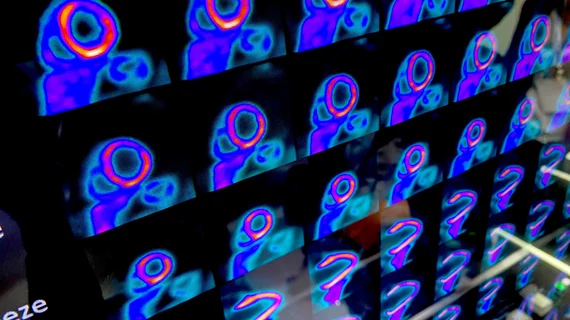How the proposed Medicare Physician Fee Schedule could impact nuclear cardiology
The American Society of Nuclear Cardiology (ASNC) has shared new comments on some of the nuclear imaging-specific information contained in the 2025 Medicare Physician Fee Schedule (MPFS) and the Hospital Outpatient Prospective Payment System (HOPPS) proposed rules that the Centers for Medicare and Medicaid Services (CMS) published last week.
Bundled payments for radiopharmaceuticals impact access to care
CMS is proposing to change the way it pays for diagnostic radiopharmaceuticals. Currently, ASNC said the costs associated with diagnostic radiopharmaceuticals are packaged into payments for nuclear imaging tests. CMS now proposes reforming the current bundling policy to pay separately for any diagnostic radiopharmaceutical with a per-day cost greater than $630 and removing these diagnostic radiopharmaceutical costs from the payment amounts for nuclear imaging tests.
ASNC said any radiopharmaceutical with a per-day cost below the $630 threshold would remain bundled. This would apply to many radiopharmaceuticals used in SPECT and PET procedures.
The CMS proposal follows mounting pressure to unbundle radiopharmaceuticals from nuclear medicine test payments, ASNC explained. Stakeholders who favor unbundling argue current packaging policies are limiting patient access to more innovative diagnostic radiopharmaceuticals.
Diagnostic radiopharmaceuticals that exceed the $630 per-day cost threshold would be assigned to an ambulatory payment classification (APC), making those radiopharmaceuticals specified covered outpatient drugs. Because few radiopharmaceutical manufacturers report current sales price data for their products, CMS believes it would be more appropriate to pay for separately payable diagnostic radiopharmaceuticals based on their mean unit costs taken from hospital claims data as a proxy. However, CMS would consider using average sales price data in the future.
ASNC said it is assessing the impact of this proposed policy on the nuclear medicine APCs.
Figuring costs for radiopharmaceuticals furnished in physician offices
CMS issued a point of clarification in the fee schedule confirming that radiopharmaceuticals furnished in settings other than hospital outpatient departments, Medicare administrative contractors (MACs) would determine payment limits for radiopharmaceuticals based on any methodology in place on, or prior to, November 2003, including the use of invoice-based pricing. ASNC said this clarification accompanies CMS’s proposed hospital outpatient radiopharmaceutical payment policy outlined above.
Medicare Fee Schedule will cut payments to physicians
CMS proposed a conversion factor for 2025 that would be a 2.8% decrease from the 2024 MPFS conversion factor. Medicare is bound by law to maintain budget neutrality, so cuts are often needed to balance the budget. These cut often come from physician payments.
ASNC emphasized that the proposed cut to the conversion factor can only be stopped by Congress. In June, the group wrote to the Senate Finance Committee asking for an annual payment update for physicians, beginning in 2025, that would be tied to the Medicare Economic Index (MEI), which is projected at 2.6% for 2025.
ASNC also expressed urgency on reforming budget-neutrality requirements to avoid cuts to the conversion factor and significant fee schedule redistribution in the future. ASNC is one of more than 100 medical societies that support American Medical Association (AMA) efforts calling on Congress to reform Medicare before patients begin to be turned away because the payments no longer cover the costs for care. The society also supports the Strengthening Medicare for Patients and Providers Act (H.R. 2474), which provides a permanent annual update equal to the increase in the MEI, and the Provider Reimbursement Stability Act (H.R. 6371), which would make much-needed reforms to budget neutrality.
"ASNC requests that passage of both bills be considered a priority," wrote ASNC President Lawrence Phillips, MD, in a letter to the Senate Committee on Finance in June.
Proposed payments for cardiovascular risk assessment and management
CMS is proposing coding and payment for atherosclerotic cardiovascular disease (ASCVD) risk assessment and risk management services. The ASCVD risk assessment would be performed in conjunction with an evaluation and management visit when a practitioner identifies a patient at risk for but without a diagnosis of CVD.
The risk assessment tool would include demographic data, modifiable risk factors for CVD, possible risk enhancers and laboratory data. The output would be required to include a 10-year estimate of the patient’s ASCVD risk. CMS is also proposing coding and payment for ASCVD risk management services that include service elements related to CVD risk reduction, such as blood pressure and cholesterol management, for beneficiaries at medium or high risk (>15 percent in the next 10 years) for CVD.
Increase expected for Outpatient Prospective Payment System
CMS proposed an update to HOPPS payment rates by 2.6%. This increase is based on the projected hospital market basket increase of 3% reduced by 0.4% productivity adjustment.

